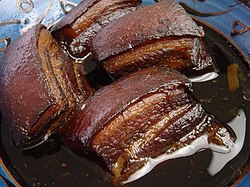| English | Traditional Chinese | Simplified Chinese | Pinyin | Picture | Notes |
|---|
| A hundred birds facing the Phoenix | 百鳥朝鳳 | 百鸟朝凤 | bǎi niǎo cháo fèng | | Xiaoshan chicken is stewed in a clay pot. Steamed dumplings are then arranged around the chicken, such that it looks like the dumplings ("hundred birds") are facing the chicken ("phoenix"). |
| Beggar's chicken | 叫化雞 | 叫化鸡 | jiàohuā jī |  | Although this dish is originally from Jiangsu Province, it was popularised in Hangzhou and has since been considered part of Hangzhou cuisine. |
| Dongpo pork | 東坡肉 | 东坡肉 | Dōngpō ròu |  | Fried pork belly stewed in soy sauce and wine. |
| Dry vegetables and stewed meat | 乾菜燜肉 | 干菜焖肉 | gān cài mèn ròu | | Meigan cai stewed with pork. |
| Fiery pupil immortal duck | 火瞳神仙鴨 | 火瞳神仙鸭 | huǒ tóng shénxiān yā | | Jinhua ham stewed with duck. |
| Fried shrimp | 油爆大蝦 | 油爆大虾 | yóu bào dà xiā | | River shrimp is deep fried first and then stir-fried. |
| Gan zha xiang ling | 乾炸響鈴 | 干炸响铃 | gān zhá xiǎng líng | | Deep-fried pieces of pork tenderloin wrapped in tofu skin. |
| Guoba with tomato and shrimp | 番茄蝦仁鍋巴 | 番茄虾仁锅巴 | fānqié xiārén guō bā | | |
| Hibiscus mud crab | 芙蓉蝤蠓 | 芙蓉蝤蠓 | fúróng qiúměng | | Mud crab cooked with egg, green vegetables, chicken stock and Shaoxing wine. |
| Home-made salted pork with spring bamboo shoots | 南肉春筍 | 南肉春笋 | nán ròu chūnsǔn | | |
| Jin yu man tang | 金玉滿堂 | 金玉满堂 | jīn yù mǎn táng | | A dish composed of shrimp, Chinese perch, deep-fried chicken, pork strips, shumai, ham, crab roe and other ingredients. |
| Large yellow croaker with pickled mustard greens | 鹹菜大湯黃魚 | 咸菜大汤黄鱼 | xiányú dà tāng huángyú | | |
| Longjing shrimp | 龍井蝦仁 | 龙井虾仁 | lóngjǐng xiārén | | Shrimp cooked in Longjing tea |
| Mi zhi da fang | 蜜汁大方 | 蜜汁大方 | mì zhī dà fāng | | Ham is steamed in syrup with lotus seeds, green plums, cherries, osmanthus and other ingredients. |
| Pearls on a palm | 掌上明珠 | 掌上明珠 | zhǎng shàng míng zhū | | Fishballs ("pearls") served on a goose web ("palm"). |
| Pregnant fresh fish | 懷胎鮮魚 | 怀胎鲜鱼 | huáitāi xiān yú | | Steamed sea bass wrapped in pig's caul fat and stuffed with shrimp, Shiitake mushroom, ham and other ingredients. |
| Razor shells with fried egg | 蛋煎蜻子 | 蛋煎蜻子 | dàn jiān qīng zǐ | | A dish composed of razor shells, pork lard, water chestnut and egg. |
| San si qiao yu | 三絲敲魚 | 三丝敲鱼 | sān sī qiāo yú | | A dish composed of abalone, ham, chicken breast, lean pork, choy sum and other ingredients. |
| Shao(xing) shrimp balls | 紹蝦球 | 绍虾球 | Shào xiā qiú | | Shrimp balls wrapped in strips of deep-fried egg paste. |
| Sister Song's Fish Soup | | 宋嫂鱼羹 | |  | A soup composed of ingredients such as Chinese perch, ham, bamboo shoots, Shiitake mushroom, egg and chicken stock. |
| Softshell turtle in crystallised sugar | 冰糖甲魚 | 冰糖甲鱼 | bīng táng jiǎyú | | |
| Stir-fried eel pieces | 生爆鱔片 | 生爆鳝片 | shēng bào shàn piàn | | Swamp eel coated in a paste, stir-fried, and served with garlic, sugar and vinegar. |
| Stir-fried shredded pork with egg white | 芙蓉肉 | 芙蓉肉 | fúróng ròu | | |
| Ten views of Shao(xing) | 紹十景 | 绍十景 | Shào shí jǐng | | A dish composed of fishballs, meatballs, shrimp, fish maw, bamboo shoot, Shiitake mushroom, chicken gizzard and other ingredients. |
| Wenzhou pig intestine rice noodle soup | | 温州猪脏粉 | Wēnzhōu zhūzàngfěn | | A rice noodle soup containing pig intestine and duck or pig blood popular in Wenzhou. |
| West Lake chuncai soup | 西湖蒓菜湯 | 西湖莼菜汤 | Xīhú chúncài tāng | | Soup made with strips of ham, chicken breast and chuncai. |
| West Lake fish in vinegar | 西湖醋魚 | 西湖醋鱼 | Xīhú cù yú | | A grass carp served in syrup. |
|




